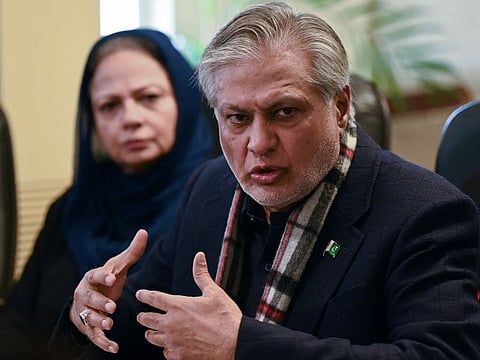Crucial $1.1 billion IMF deal eludes Pakistan for now; talks continue
IMF mission leaves after 10 days of talks aimed at releasing funds, part of $6.5b bailout

KARACHI: Pakistan and the International Monetary Fund said on Friday they were still discussing a deal to provide the South Asian nation with $1.1 billion in funds critical to keeping its economy afloat.
An IMF mission left Islamabad on Friday after 10 days of talks aimed at releasing the funds, part of a $6.5 billion bailout that Pakistan signed in 2019.
Finance Minister Ishaq Dar told reporters Pakistan had agreed with the IMF on the conditions to release the funds, which has been delayed since last December. Talks with the IMF would resume virtually on Monday, he said, adding that “routine procedures” were behind the delay.
“We will implement whatever has been agreed upon between our teams,” Dar said. In a statement, Pakistan IMF Mission Chief Nathan Porter confirmed talks were continuing, adding that considerable progress had already been made.
Pakistan is in dire need of a successful outcome. The $350-billion economy is still reeling from devastating floods last year, and the government estimates rebuilding efforts will cost $16 billion.
The heavily indebted nation only has enough foreign reserves to cover less than three weeks of crucial imports. The longer it takes for the IMF tranche to be paid out, the higher the risk of default , analysts say.
What has Pakistan agreed so far with the IMF
Below are the key points Pakistani authorities say they have already reached agreement on with the IMF: * The government will implement fiscal measures, including taxation, to raise 170 billion Pakistani rupees ($629.63 million) worth of revenue * The government’s existing commitments to increase petroleum levies will be completed. Diesel levies will be raised twice by 5 rupees per litre each time on March 1 and April 1. * Energy reforms suggested by the IMF will be discussed and approved by Pakistan’s cabinet. This would including Pakistan completely slashing its circular debt - a form of public debt that builds up in the power sector due to subsidies and unpaid bills. Eliminating circular debt entirely was not an immediate requirement. In the meantime, Pakistan would not add any circular debt related to gas.
Last week, Prime Minister Shehbaz Sharif called Pakistan’s economic situation “unimaginable.” “Ideally, Pakistan should have reached a staff level agreement at the end of the IMF mission,” Khaqan Najeeb, a former finance ministry adviser, told Reuters.
“Delay is untenable.” The so-called staff-level agreement, which then needs to be approved by the IMF’s head office in Washington, must be reached before the funds are disbursed.
In addition to the stalled tranche, another $1.4 billion remain of the $6.5 billion bailout programme, which is due to end in June.
Experts said Pakistan needs the payout as soon as possible. “If this drags on for, say, longer than a month, things get more difficult as our forex reserves have reached a critical level,” former central bank Deputy Governor Murtaza Syed told Reuters.
Pakistan’s macro economic indicators
The International Monetary Fund has asked for more time for negotiations with Pakistan over a deal that would unlock much-needed funds from a $6.5 billion programme. Below are four key economic indicators of the cash-strapped country. FOREX RESERVES Pakistan’s foreign exchange reserves have fallen to the lowest level in 10 years and cover only three weeks’ worth of imports. In the week ending January 27, the central bank’s foreign currency reserves shrank to $3.09 billion, down $592 million from previous week. INFLATION Inflation has averaged at a record high 25.4 per cent for the seven months of the current fiscal year that started last July compared to 10.3% in the same period in the previous fiscal year. The consumer price index rose 27.5 per cent year-on-year in January, the highest in nearly half a century. Last month, the central bank raised its key interest rate by 100 basis points to 17 per cent in a bid to rein in persistently high inflation, and said achieving price stability was key to attaining sustainable economic growth in the future. The bank has raised the key rate by a total 725 bps since January 2022. CURRENT ACCOUNT DEFICIT Pakistan’s current account deficit shrank to around $400 million in December 2022 from $1.9 billion a year earlier, as the government slashed imports in a bid to avert an external payments crisis. PAKISTANI RUPEE The rupee reached a record low of 276.58 to the dollar in the inter-bank market on Feb. 3. The rupee has dropped over 35 per cent in the last 12 months.
The conditions set by the IMF include a return to a market-based exchange rate and higher fuel prices, measures that Pakistan recently implemented and that have already sent inflation to a record high - 27.5 per cent year-on-year in January - and created shortages in some imported goods.
Dar said Pakistan had also agreed with the IMF to introduce fiscal measures, including new taxes.
Analysts fear more fiscal tightening could tip the economy further into crisis.
“The government has not only wasted over five months in realising the gravity of the situation, it is still sleepwalking the country into an economic abyss,” said Sakib Sherani, who served as the finance ministry’s principal economic adviser in 2009-10.
The fund has given new instructions to Pakistan to raise and collect taxes, as well as slash subsidies without burdening poor people, government officials said.
Sharif last week warned that Pakistan would have difficulty complying with the IMF’s conditions.
On Friday, Pakistani Finance Minister Ishaq Dar said Pakistan will impose additional taxes of 170 billion rupees and slash subsidies to meet the deal’s terms.
Sign up for the Daily Briefing
Get the latest news and updates straight to your inbox



